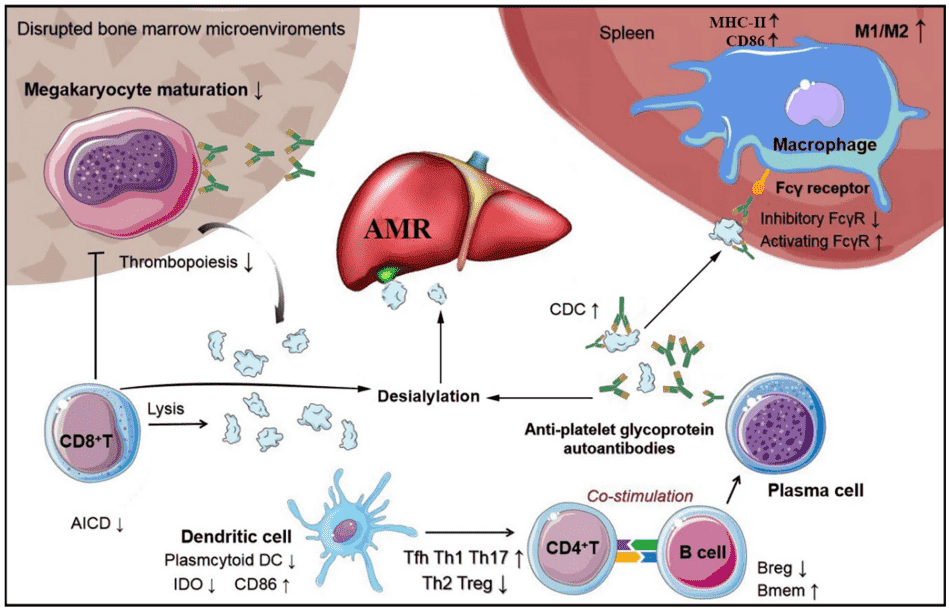NAA and Immune Thrombocytopenic Purpura (ITP)
Immune thrombocytopenic purpura (ITP) is an autoimmune disease with antibodies detectable against several platelet surface structures, whose occurrence is usually associated with natural-autoantibody (NAA). Therefore, the research of NAA provides a novel method in the diagnosis and treatment of ITC and offers a clearer understanding of the pathology. As an experienced expert in antibody technology, Creative Biolabs is committed to providing one-stop NAA services and first-class NAA products to our clients targeting various diseases.
Introduction of Immune Thrombocytopenic Purpura
ITP is a type of thrombocytopenic purpura defined as an isolated low platelet count with normal bone marrow in the absence of other causes of low platelets. Clinical manifestations include petechiae, purpura, and ecchymosis that occur primarily in the upper and lower extremities while fatal complications are less common. Two distinct clinical syndromes manifest as an acute condition in children and a chronic condition in adults. The acute form often induces an infection and has a spontaneous resolution within two months. Chronic immune thrombocytopenia persists longer than six months and the specific cause is also unknown. ITP can be diagnosed by identifying a low platelet count on a complete blood count usually less than 150,000 u/L, and a bone marrow biopsy may be also necessary in some cases. ITP is reported in approximately 2 per 100,000 adults with a mean age of diagnosis of 50 years.
Immune Thrombocytopenic Purpura Develop Pathway
Although the pathogenesis is still unclear, ITP is believed to result from the development of an immunoglobulin G autoantibody targeting structural platelet membrane glycoproteins IIb-IIIa. This renders platelets susceptible to phagocytosis by splenic macrophages and Kupffer cells in the liver. These autoantibodies are detected in 40-60% of individuals. As Fig.1 shows, the antiplatelet antibodies play a central role in immunopathology. Since the platelet is intravascular, the initial immune response occurs in the spleen and possibly to some extent in the bone marrow. Eventually, antigen-specific memory cells develop, circulate, and initiate a more generalized immune response. IgG antiplatelet antibody is produced and cytotoxic T lymphocytes are generated. Autoantibody binds to platelets, causing their destruction by either phagocytosis or complement-induced lysis and to megakaryocytes resulting in decreased maturation and cell death. Cytotoxic T lymphocytes result in platelet lysis and, possibly, megakaryocyte lysis. Solid lines show reactions with solid experimental evidence and dashed lines show reactions that are postulated. The production of IgG NAA is the cause of the ITP, therefore, the detection and analysis of NAA can be an indication to support the diagnosis of ITP.
 Fig.1 Pathophysiology of ITP.1
Fig.1 Pathophysiology of ITP.1
NAA Services for Immune Thrombocytopenic Purpura at Creative Biolabs
- NAA Services for Anti-Platelet
- NAA Services for Anti-Cardiolipin
- NAA Services for Anti-Lupus Anticoagulants (LA)
- NAA Services for Anti-Phospholipid
- NAA Services for Anti-β2 Glycoprotein 1
Immune Thrombocytopenic Purpura Related Products at Creative Biolabs
Creative Biolabs provides various NAA detection kits with high specificity and sensitivity which can act as a one-stop toolbox for studying disease pathways with NAA and screening for potential biomarkers.
Based on our established platforms and skilled employees, Creative Biolabs has achieved many remarkable goals in the NAA research and offered satisfactory services to global clients. Our high-quality products and services will contribute greatly to the success of your projects. Please feel free to contact us for more information and a detailed quote.
Reference
- Liu, Xin-guang, Yu Hou, and Ming Hou. "How we treat primary immune thrombocytopenia in adults." Journal of Hematology & Oncology 16.1 (2023): 4.

